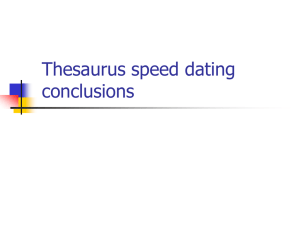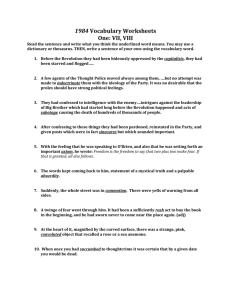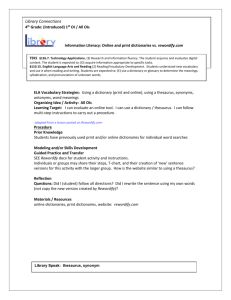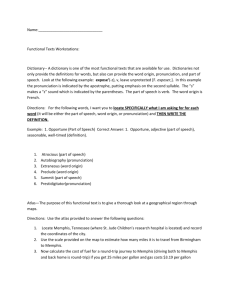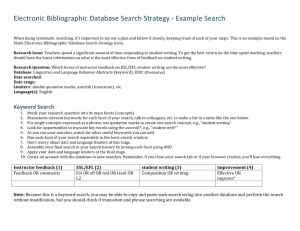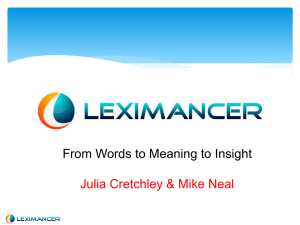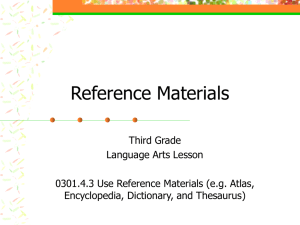DL 99 NKOS Workshop - Kent State University
advertisement
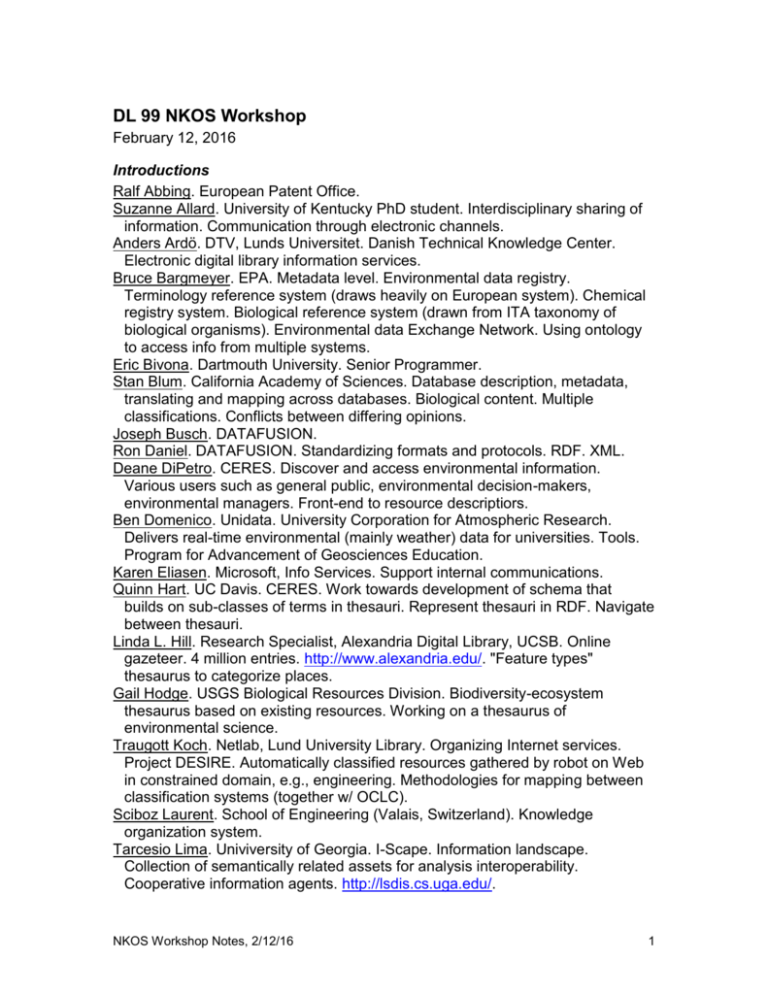
DL 99 NKOS Workshop February 12, 2016 Introductions Ralf Abbing. European Patent Office. Suzanne Allard. University of Kentucky PhD student. Interdisciplinary sharing of information. Communication through electronic channels. Anders Ardö. DTV, Lunds Universitet. Danish Technical Knowledge Center. Electronic digital library information services. Bruce Bargmeyer. EPA. Metadata level. Environmental data registry. Terminology reference system (draws heavily on European system). Chemical registry system. Biological reference system (drawn from ITA taxonomy of biological organisms). Environmental data Exchange Network. Using ontology to access info from multiple systems. Eric Bivona. Dartmouth University. Senior Programmer. Stan Blum. California Academy of Sciences. Database description, metadata, translating and mapping across databases. Biological content. Multiple classifications. Conflicts between differing opinions. Joseph Busch. DATAFUSION. Ron Daniel. DATAFUSION. Standardizing formats and protocols. RDF. XML. Deane DiPetro. CERES. Discover and access environmental information. Various users such as general public, environmental decision-makers, environmental managers. Front-end to resource descriptiors. Ben Domenico. Unidata. University Corporation for Atmospheric Research. Delivers real-time environmental (mainly weather) data for universities. Tools. Program for Advancement of Geosciences Education. Karen Eliasen. Microsoft, Info Services. Support internal communications. Quinn Hart. UC Davis. CERES. Work towards development of schema that builds on sub-classes of terms in thesauri. Represent thesauri in RDF. Navigate between thesauri. Linda L. Hill. Research Specialist, Alexandria Digital Library, UCSB. Online gazeteer. 4 million entries. http://www.alexandria.edu/. "Feature types" thesaurus to categorize places. Gail Hodge. USGS Biological Resources Division. Biodiversity-ecosystem thesaurus based on existing resources. Working on a thesaurus of environmental science. Traugott Koch. Netlab, Lund University Library. Organizing Internet services. Project DESIRE. Automatically classified resources gathered by robot on Web in constrained domain, e.g., engineering. Methodologies for mapping between classification systems (together w/ OCLC). Sciboz Laurent. School of Engineering (Valais, Switzerland). Knowledge organization system. Tarcesio Lima. Univiversity of Georgia. I-Scape. Information landscape. Collection of semantically related assets for analysis interoperability. Cooperative information agents. http://lsdis.cs.uga.edu/. NKOS Workshop Notes, 2/12/16 1 Steve Lussier. UC Berkeley graduate student. Representation and user interface. Marilyn Ostergren. National Parks Service Natural Resource Bibliography Field Director. Developing thesaurus. Indexing. Thesaurus construction development. Bill Pease. UC Berkeley. Public Health. http://www.scorecard.org/. Needs to dynamically acquire data from multiple data sources. Bridging different ontologies. Jacek Purat. UC Berkeley, SIMS. Environmental classification systems. Native, science, and bibliographic types of classification schemes. Multilingual environmental thesauri. Dagobert Soergel. University of Maryland. Thesaurus builder, ontological engineer. System of integrated access to many distributed knowledge structures (SemWEB). Help user to construct meaning for learning and for query formulation. Thronton Staples. University of Virginia, Director of Digital Library Resources Group. Full SGML e-texts that need to be integrated. Digital repository architecture, e.g., Fedora (Lagoze). Roger Thompson. OCLC Office of Research. Implementation of information retrieval systems Diane Vizine-Goetz. OCLC. Mapping vocabularies to Dewey. Bioethics thesaurus mapping. How to code relationships to the scheme? How to use the scheme? Richard White. Southampton University. Biological Resources. Databases of species of organisms. ILVIS legumes database. http://www.ilvis.org/ search by species name. Species 2000 http://www.sp2000.org/ documenting biodiversity. GBIF (Global Biodiversity Information Facility) is linking together species databases. LITCHI linking from species databases to other resources. Lei Zeng. Kent State University SLIS. Thesaurus development for non-librarians. IMLS reports. Templates for indexing administrative reports. 3D objects historical costumes digital collection. Paul Zhang. Lexis/Nexis Research Scientist. Indexing taxonomy & thesaurus building. Deeper analysis of content. Fact mining. Xe? (Korea) Parallel processing. Digital libraries. NKOS Thesaurus Registry Working Group Update Data elements needed to describe a networked vocabulary resource so could be used by different clients and browsers that don't know anything about the resource. Based on previous work by L. Hill and Mike Raugh (Interconnect Technologies). Draft on NKOS Web site. Biodiversity pilot. Part of BRD/CERES vocabulary for biodiversity and ecosystem science. Access Database based on draft registry specification. Works better for thesauri than other vocabularies. Difficult for cataloger to complete fields. Better to have owners create registry record. Need: more IP info; classification scheme. Next steps. NKOS Workshop Notes, 2/12/16 2 Develop taxonomy for vocabularies Reconciliation of elements against other similar efforts. E.g., Ann Betz in Germany. Finalize draft. (BRD needs to finalize something in next 3 months) ** Develop XML representation of metadata for vocabulary resource Approach NISO to host review of this work. Broaden the context. Pease. Map elements to currently implemented standards, e.g., ICE, (Information Content Exchange) for remote and dynamic exchange, a central brokering point. ** Map to XML, RDF, Dublin Core -- essential. Soergel. Analytical info. Editorial info. Vizine-Goetz. Rights management issues are complex. Many resources are dynamic. Zeng. Construction standard followed. Hill. Uses matters. NKOS Reference Model Working Group Update Ron Davies was chair. Data and process, model and architecture behind querying KO (knowledge organization) resources. What are query scenarios? What is relationship to Zthes? CERES FGDC cataloging project. Robots that scan agency sites. Theme thesaurus-- broad scope, shallow depth. Linkages with other thesauri. Needs: cataloging vs. searching. Distributed architecture Single, standard client interface to access thesaurus for various needs Easily embedded in other applications Focus on Web tools Simple servers RDF format method for thesaural content. Explicit thesaurus interoperability. Support for multiple vocabulary types-- world lists, thesauri, gazetteers. Handling of "synonyms" across thesauri is not handled same way this is specified in Z39.19. E.g., Z39.19 specifies use of qualifier to distinguish homonyms. CERES uses source in square brackets. E.g. "biodiversity" occurs in multiple thesauri but these are not explicit synonyms, i.e., they have different contexts. Standard method for how thesaurus server responds to a query; but don't specify how "relevancy" is determined. Specifications for query response is on the CERES server. Same schema for entire thesauri. The CERES Standard NKOS Workshop Notes, 2/12/16 3 How you questions to a server. Syntax and RDF schema of the way the server responds. Most basic class is controlled vocabulary. Subclass is word list. Subclass is thesaurus. Term is property of word list, etc. Check spec online. Relationships between thesauri Simple reference link. Same term but not necessarily equivalent. Extension link. An equivalent concept that extends the thesaurus, e.g., with narrower terms. Daniel. RDF and Thesauri Z39.19 RDF data model- based on DLG's (directed labeled graphs). Can use to describe a thesaurus. RDF syntax- expressed in XML. Uses URI's as node and arc labels. RDF schemas- proposed recommendation; make it easier to build models for particular problem domains. Dan Brickley: Rule-based metadata crosswalks using RDF http://purl.org/net/rdf/papers/classmap. Few commercial applications or tools at this time. But seems particularly useful for thesaural information objects. Zeng. Multi Thesauri Management System CAMed. Complimentary and Alternative Medicine. Databases & Web sites Search distributed database from one source. Terminology problems, system design requirements. Terminology repository to allow cross-thesauri searching; and conceptual framework to map concepts. Browse various displays, cross thesaurus searching, thesaurus management functions. ISO 2788 http://circe.slis.kent.edu/mzeng/macmed/thesaurihome.html IMLS Lexicon, NKOS test-site. Bargmeyer. Metadata Registries Data elements and data element concepts, different representations without having to choose one. Making the mappings available. ISO 11179 Metadata Registry. Data changes need to be tracked. Standardize at the conceptual content level. Can organize thesaurally or by data elements. Manage data elements as organizations of terms (not do this within the thesaurus itself) Organize data elements into-- NKOS Workshop Notes, 2/12/16 4 database design, Web-enabled forms, and Documents. Terminology reference system. Open Forum of Metadata Registries, 1/17-21, 2000 Santa Fe. http://www.nist.gov/L8/sc32wg2/2000/events/openforum/index.htm Document diversity, encourage consistency. Eliasen. Microsoft Information Services Vocabularies, tools, & metrics. Knowledge Architecture group within Microsoft Information Services. Company-wide shared thesaurus developed with consultants and vendors. Internal and external audit of vocabularies and metadata schemas. Revised focus from term concentration to metadata schema collection and coordination & tools to support approach. Tools- Vocabulary storage and management (needed to support multiple vocabularies) Metadata schema management Exposing vocabulary to end users (tagging and searching) Sample applications and solutions kit for developers (APIs) Integrated with existing tools. Metrics- quantitative, qualitative, cost. Exciting Points Stan. Make projects more visible & accessible. Tools and explanations of what's going on. Dagobert. Registry of thesauri, etc. Ceres: Accessing multiple thesauri- use as starting point for group next steps. Microsoft: validating value of vocabularies. Deanne. Combine resources to build and use CERES as testbed. Bruce. Thinking things we can possibly do together. Great name. But huge scope. What is scope of group really meant to be? What are we trying to accomplish? Richard. Relationship to biological taxonomy. Jacek. Important to distinguish between nomenclature and classification. Anders. Standards needed for systems to interoperate. Communicate and schema representation. Next Steps Work on the CERES protocol. Need to find funding. Online brainstorming - a good narrative, scope, pre-proposal period, identifying partnerships, vision. Vocabulary management tool. Links with other organizations- terminology. Lists of existing tools and information sources-- NKOS Workshop Notes, 2/12/16 5 ASI review site http://www.jelem.com/ More publicly hosted Web sites? Taxonomy of knowledge organization systems. NKOS Workshop Notes, 2/12/16 6

